
* In the 1960s, in response to a US military scout helicopter requirement, the Hughes Helicopters firm introduced the "OH-6A" scout helicopter, which saw intensive combat in Vietnam. It was mirrored by a civil / export variant, the "Model 500". After a rocky start, the H-6 / Series 500 became a highly successful helicopter, still being produced in improved variants in the 21st century. This document provides a history and description of the H-6 / Series 500 helicopter family -- as well as the "no tail rotor (NOTAR)" helicopters that were an offshoot of the line. A list of illustration credits is provided at the end.
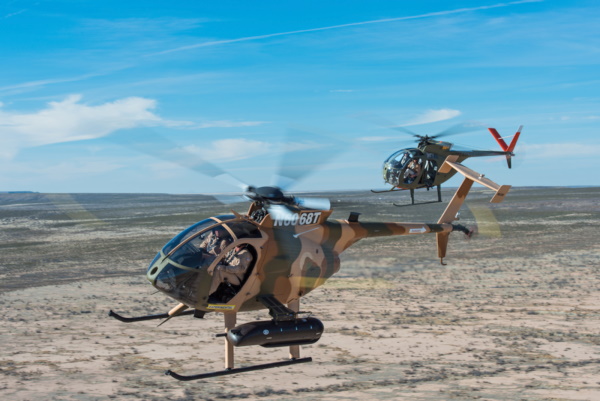
* In 1960, the Hughes Helicopter division introduced its first production helicopter, the "Model 269", a lightweight two-seat machine for training and utility roles. It led to the slightly refined "Model 300", with three seats, the Model 269 and Model 300 proving popular.
In 1960, the US Army announced a "Light Observation Helicopter (LOH)" competition under "Technical Specification 153", with a prospect of large numbers of sales by the winner. The rotorcraft was to have four seats and be powered by a single turboshaft engine. Leveraging off experience acquired with the Model 269, Hughes submitted the "Model 369" to the competition; it was accepted for evaluation, being given the military designation of "YHO-6", changed in 1962 to "YOH-6", with the operational designation of "OH-6". Two competing designs were accepted for evaluation as well:
The Army ordered prototypes of the three offerings, with all to be powered by the Allison T63 turboshaft. The first of five Model 369 prototypes performed its initial flight on 27 February 1963, being powered by an Allison T63-A-5 turboshaft engine. The Bell OH-4A quickly eliminated from the competition as too expensive and less capable.
The Hiller OH-5A seemed poised to win, being superior to the Hughes OH-6A in most respects -- but the reclusive Howard Hughes, ultimate boss of Hughes Helicopters, was determined to win, lobbying procurement personnel with "babes, booze, and bribes", and then recklessly underbidding the price of the OH-6A. In any case, the Model 369 won the competition in May 1965, with the US Army initially ordering 714 "OH-6A Cayuse" machines, with the type being introduced to service in Vietnam in 1966.
* As it emerged, the OH-6A had a clear evolutionary relationship to the Model 269 / 300, but there was little or no parts commonality. The OH-6A was not only bigger, it also had a proper fuselage, not just the bubble cockpit and open frame of the Model 269 / 300. The OH-6A was of conventional main / tail rotor helicopter configuration, made mostly of aviation aluminum alloys, with an egg-shaped fuselage, a tailboom, and twin landing skids. It had a four-blade main rotor -- which could be folded for transport and storage -- and a two-blade tail rotor, mounted to the left; there were tailfins above and below the end of the tailboom, and an angled tailplane to the right, forming a lopsided "vee" tail. The tailplane was hooked up to the top tailfin by a strut.

The landing skids were faired for aerodynamic efficiency, and had shock absorbers to help compensate for a rough landing. The OH-6A had doors fore and aft on each side of the fuselage, hinged on the front; the rear doors were often removed for operations in tropical environments, with the front doors occasionally removed as well. The rear seats could be folded down for cargo hauling, there being cargo tie-downs on the floor.
The T63-A-5 turboshaft was derated to a take-off rating of 190 kW (250 SHP) and a continuous rating of 160 kW (215 SHP). It was covered by clamshell doors that hinged open, with the engine being easily removed for servicing. There were twin bladder-type self-sealing fuel tanks under the floor, with a total capacity of 232 liters (61.5 US gallons). Avionics were simple, consisting of radios and flight / navigation kit.
___________________________________________________________________
HUGHES OH-6 CAYUSE / LOH:
___________________________________________________________________
main rotor diameter:
8.03 meters (26 feet 4 inches)
tail rotor diameter:
1.3 meters (4 feet 3 inches)
fuselage length:
7.01 meters (23 feet)
footprint length:
9.24 meters (30 feet 4 inches)
height (rotor head):
2.48 meters (8 feet 2 inches)
empty weight:
533 kilograms (1,176 pounds)
max loaded weight:
1,090 kilograms (2,400 pounds)
maximum speed:
240 KPH (150 MPH / 130 KT)
service ceiling:
4,815 meters (15,800 feet)
hover ceiling in ground effect:
3,595 meters (11,800 feet)
hover ceiling out of ground effect:
2,225 meters (7,300 feet)
range:
610 kilometers (380 MI / 330 NMI)
___________________________________________________________________
The OH-6A could be armed with a pivoting M134 7.62-millimeter Gatling Minigun on a pylon on the left side, with a 7.62-millimeter M60 machine gun on a flexible mount on the right rear door. An automatic 40-millimeter grenade launcher, mounted in place of the Minigun, was evaluated, but it seems not used in combat.
The OH-6A gave a good account of itself in Vietnam -- acquiring the nickname of "Loach", derived from the "LOH" competition name. It apparently suffered substantial combat attrition, not so much from design failings, but because it was thrown into the thick of the action, the grim joke going around: "The target is marked by the burning Loach." Not having much in the way of protection, it was vulnerable to ground fire; but the Viet Cong were not generally inclined to open up on it, since the Loach was often teamed up with an AH-1 Cobra gunship that would respond with heavy firepower. There were no complaints about its performance, the OH-6A being fast and agile, having set records for speed and climb rate, as well as endurance, in 1966.
However, having wildly underbid costs on the machine, Howard Hughes was suffering -- as the old industrial gag has it, Hughes was losing money on each item, but trying to make up for it in volume. After the initial production batch had been delivered, the Army ordered follow-on production, with Hughes then almost tripling the price. That attracted the attention of Congress.
The Army responded to the drastic price increase by pointing out a clause in the contract that allowed the service to continue buying OH-6As at the original price; Howard Hughes was forced to back down, but production of OH-6As at Hughes Aircraft slowed to a crawl. Congress then intervened, stipulating that the Army cancel the contract with Hughes Helicopters and re-start the LOH competition. The second contract was awarded to Bell for the Model 207 / OH-58A Kiowa. Hughes built a total of 1,434 OH-6s, with Army records indicating 658 lost in combat action, with 269 lost in operational accidents as well.
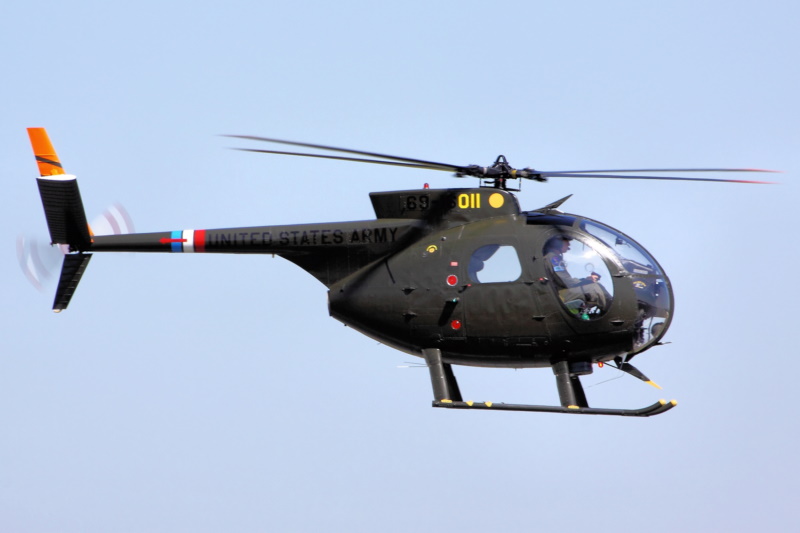
* After the conflict, the OH-6A was gradually phased out to the US Army Reserve and National Guard. From the late 1980s, survivors were upgraded to "OH-6B" configuration, with:
The US Navy also obtained six "TH-6B" trainers, which were dual-control versions of the OH-6 with the T63-A-720 engine, but no operational enhancements. They are flown by the US Navy Test Pilots School at Patuxent River in Maryland, presumably to give students experience in flying fast light helicopters. They were introduced into service in the early 1990s; sources are not entirely clear on their origins, but it seems they were modified from OH-6Bs.
In addition, the US Customs & Border Patrol inherited a total of 42 OH-6As from the US Army, beginning in 1979, with these machines later updated to support night vision goggle (NVG) operation. Customs retired their OH-6As in 2011. Other Army OH-6As had apparently "second lives" as well, but trying to trace down details is difficult.
BACK_TO_TOP* Hughes offered a civil version of the OH-6A as the "Model 500". It was generally the same, the major difference being an Allison 250-C18A turboshaft engine, derated to 205 kW (275 SHP) take-off power and 180 kW (245 SHP) continuous. It also featured a re-arranged interior that yielded more space, as well as increased fuel tankage. It had stronger landing gear to permit attachment of floats. Max take-off weight was increased by 68 kilograms (150 pounds).
The Model 500 was available in seven-seat, or five-seat executive configurations. It could also, in principle, be configured as an air ambulance, with two stretchers and medical attendants. A wide range of customer options was offered, including dual controls, a cargo sling hook, inflatable flotation gear. Somewhere along the line, taller landing gear would be introduced as an option, it seems to help deal with rough terrain, though exactly when this was offered in the history of the Series 500 is unclear. A "500S", later redesignated "500C", utility version was also introduced that had an Allison 250-C20 engine -- with the same deratings as the 250-C18A, but it seems with longer redline limits -- for "hot & high" operations.
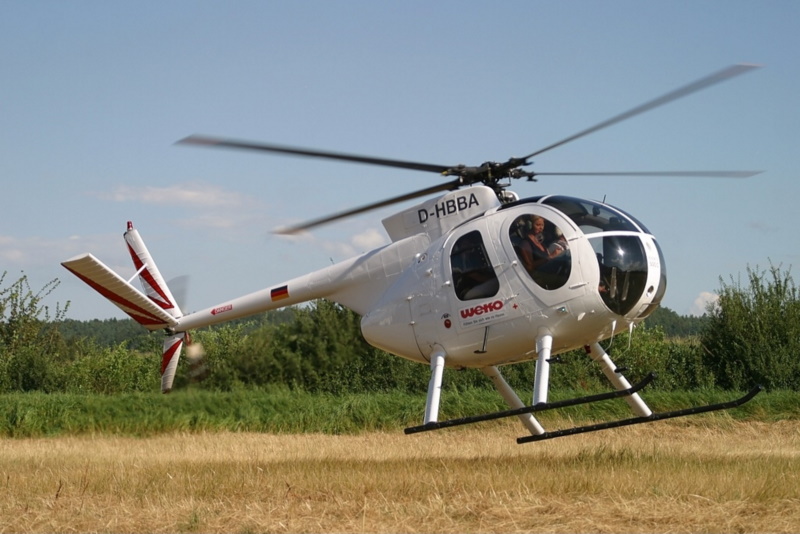
The "Model 500D" was introduced in 1976, this version trading the old lopsided vee tail for a tee tail, with finlets on the ends of the tailplane; a quieter five-blade main rotor, and an optional four-blade "quiet" tail rotor. It had an Allison 250-C20B engine, it seems with 280 kW (375 SHP) for take-off and 260 kW (350 SHP) continuous, and an improved drivetrain. These items had been evaluated from 1971 with an OH-6A modified under a program run by the Pentagon's "blue sky" research office, the Advanced Research Projects Agency, using a similarly kitted OH-6A.
The Model 500D was replaced in production in 1982 by the "Model 500E", with a modified "pointy nose" fuselage, featuring a more capacious interior, with improved soundproofing. Confusingly, the executive version of the original Model 500 was also known as the Model 500E, though that usage was later dropped. The powerplant and drive system of the Model 500E was apparently much the same as for the Model 500D, with an Allison 250-C20 engine featuring the same deratings.
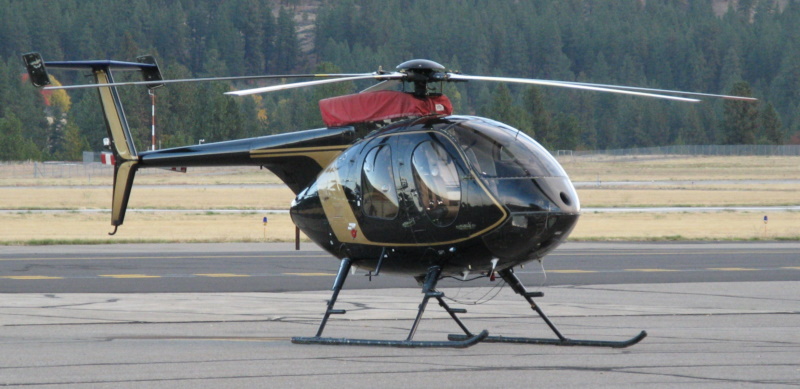
A Model 500E for "hot & high" operation was sold as the "Model 530F Lifter". The Model 530F featured an Allison 250-C30 engine, derated to 315 kW (425 SHP) for take-off and 260 kW (350 SHP) continuous, with a transmission that could handle 320 kW (425 SHP). It also had rotor blades extended in span from 8.05 meters (26 feet 5 inches) to 8.33 meters (27 feet 4 inches), and tail rotor span increased from 1.4 meters (4 feet 7 inches) to 1.45 meters (4 feet 9 inches).
___________________________________________________________________
MODEL 530F LIFTER:
___________________________________________________________________
main rotor diameter:
8.03 meters (26 feet 4 inches)
tail rotor diameter:
1.45 meters (4 feet 9 inches)
fuselage length:
7.49 meters (24 feet 7 inches)
footprint length:
9.94 meters (32 feet 7 inches)
height (rotor head):
2.67 meters (8 feet 9 inches)
empty weight:
722 kilograms (1,591 pounds)
max loaded weight:
1,610 kilograms (3,100 pounds)
max loaded weight with external load:
1,701 kilograms (3,750 pounds)
maximum speed:
250 KPH (155 MPH / 135 KT)
service ceiling:
5,700 meters (18,700 feet)
hover ceiling in ground effect:
4,875 meters (16,000 feet)
hover ceiling out of ground effect:
4,390 meters (2,895 feet)
range:
380 kilometers (235 MI / 205 NMI)
___________________________________________________________________
The Model 500E and 530F continue to be sold, with a Garmin glass cockpit now being offered as a customer option, plus work on advanced composite rotor blades with less weight and longer lifetime.
* In early 1984, McDonnell Douglas bought up Hughes Helicopters, with the Model 500E and Model 530E becoming the "MD 500E" and "MD 530E Lifter". McDonnell Douglas moved forward on altering the series to a "no tail rotor (NOTAR)" configuration, with work on the "MD 520N" and hot & high "MD 530N" being formally launched in early 1989. The first MD 530N performed its initial flight on 29 December 1989, with the first MD 520N following on 1 May 1990. The MD 530N was abandoned, customer interest being focused on the MD 520N, with the type being certified in September 1991, and initial customer deliveries at the end of the year.

The NOTAR configuration of the MD 520N eliminated the tail rotor in favor of a fan system driven by the engine, with the fan air driven down a "fat" tailboom and though vents; the NOTAR scheme had been trialed on a modified OH-6 from 1981. It was not as simple as blasting air out the tailboom to cancel torque, however, NOTAR instead relying on the "Coanda effect", discovered by Romanian-born engineer Henri Coanda (1886:1972).
In 1924, Coanda determined that airflow over a surface will hug that surface and can generate lift. In the MD NOTAR system, the tailboom had two long, fixed horizontal slots, at the 3:00 and 5:00 positions, as seen facing forward on the helicopter. Air vented through the slots altered the downwash from the main rotor, generating a sideways lift that canceled torque. Although the slots were not adjustable, the fan blades did have variable pitch, allowing the volume of air through the slots to be varied, resulting in yaw to the left or right. There was also a rotating cone at the very end of the tail that allowed about a third of the tailboom airflow to be shifted from left to right, providing fine yaw control.
Both the fan pitch and the cone were adjusted using the pilot's foot pedals. Once the helicopter was in fast forward motion, the large tailfins flanking the end of the tailboom tended to keep the machine flying straight. The primary advantage of NOTAR was elimination of the potentially dangerous tail rotor; it was also quieter. The MD 520N was powered by an Allison 250-C20R turboshaft, derated to 315 kW (425 SHP) for take-off and 280 kW (375 SHP) continuous.
___________________________________________________________________
MD HELICOPTERS MD 520N (STANDARD CONFIGURATION):
___________________________________________________________________
main rotor diameter:
8.33 meters (27 feet 4 inches)
fuselage length:
7.77 meters (25 feet 6 inches)
footprint length:
9.79 meters (32 feet 1 inch)
height (rotor head):
2.74 meters (9 feet)
empty weight:
720 kilograms (1,585 pounds)
max loaded weight:
1,520 kilograms (3,350 pounds)
max loaded weight with external load:
1,745 kilograms (3,850 pounds)
cruise speed:
230 KPH (140 MPH / 125 KT)
service ceiling:
4,025 meters (13,200 feet)
hover ceiling in ground effect:
2,835 meters (9,300 feet)
hover ceiling out of ground effect:
1,705 meters (8,780 feet)
range:
365 kilometers (225 MI / 200 NMI)
___________________________________________________________________
The MD 520N led to the stretched "MD 600N", originally the "MD 630N", with a longer fuselage to accommodate an extra row of seats. Other changes included a longer tailboom, a six-blade main rotor, and of course, to handle the greater weight, a more powerful Allison 250-C47 engine, with 445 kW (600 SHP) for take-off and 430 kW (575 SHP) continuous. There were three doors on each side, the front two doors hinged to open forward, the rear door opening backward.

Initial flight of the prototype, converted from an MD 530F, was on 22 November 1994, with certification and first deliveries in 1997. In that year, Boeing absorbed McDonnell Douglas; in 1999, Boeing sold off the MD helicopters division to RDM Holdings of the Netherlands, resulting in the firm "MD Helicopters (MDH)".
___________________________________________________________________
MD HELICOPTERS MD 600N (STANDARD CONFIGURATION):
___________________________________________________________________
main rotor diameter:
8.38 meters (27 feet 6 inches)
fuselage length:
8.99 meters (29 feet 6 inches)
footprint length:
10.79 meters (35 feet 5 inches)
height (rotor head):
2.65 meters (8 feet 8 inches)
empty weight:
955 kilograms (2,100 pounds)
max loaded weight:
1,860 kilograms (4,100 pounds)
max loaded weight with external load:
2,040 kilograms (4,500 pounds)
cruise speed:
250 KPH (155 MPH / 135 KT)
service ceiling:
4,115 meters (13,500 feet)
hover ceiling in ground effect:
3,385 meters (11,100 feet)
hover ceiling out of ground effect:
1,830 meters (6,000 feet)
range:
475 kilometers (295 MI / 255 NMI)
___________________________________________________________________
The following list describes the evolution of the OH-6A:
License production of Series 500 helicopters was performed by foreign firms in several nations:
* In parallel with the civil Series 500 line, Hughes and later McDonnell Douglas sold the same basic machines for military service, under the name of "Defender". They tracked the variant history for the civil Series 500s, with a rough correspondence in designations as follows:
civil Defender _____________ _______________ 500 500M 500D 500MD 500E 500MG 530F 530MG _____________ _______________
It appears a militarized MD 520N was offered -- simply as the "MD 520N Defender" -- but it's unclear if any were sold to export users. In any case, the Defenders featured various options for military avionics, at various levels of sophistication; exhaust suppressors; inlet dust protectors; armor protection; and self-sealing fuel tanks.
The Defenders were often sold unarmed for light utility, air ambulance, or (with dual controls) training roles -- but they were also sold in three general armed configurations:
There was a long list of buyers and license builders for the Defenders, including Afghanistan, Argentina, Chile, Colombia, Croatia, El Salvador, Finland, Honduras, Iraq, Israel, Italy, Japan, Jordan, Kenya, Mexico, Panama, Philippines, South Korea, and Taiwan. They were not only operated by military services, but also, in less sophisticated configurations, by border patrol, security police, or other paramilitary organizations.
Trying to figure reliably figure out the numbers and configurations of Defenders sold to different users would be very difficult -- all the more so because there were likely transfers between foreign users, and possibly use of US Army OH-6A hand-me-downs. The "mix and match" of helicopter options tended to vary as per user requirement, and there were also various marketing names for specialized Defender subvariants.
* In April 1980, the US military attempted to perform a mission to rescue hostages being held by Iranian militants at the US embassy in Tehran. The operation, codenamed EAGLE CLAW, was a disastrous failure, with nothing going right, culminating in the collision of a C-130 transport and an RH-53 heavylift helicopter in the Iranian desert. Eight personnel were killed.
There was considerable soul-searching among the military in the wake of EAGLE CLAW, with the US Army concluding it needed to get more serious about special operations. One of the consequences was the formation of the "160th Special Operations Aviation Regiment (SOAR)", AKA the "Night Stalkers", which was in charge of helicopter support for special operations. One of the 160th's requirements was for a light helicopter for scout, commando insertion, and gunship duties, that could be easily transported by C-130 or other cargolifter.
The H-6 was seen as a good fit, with three different configurations obtained for Special Operations Command (SOCOM) missions, general configurations being as follows:
They had folding tailbooms for air transport, and often had undernose imager turrets -- or at least later machines did, the configurations clearly having evolved over time. Trying to track down the changes and quantities of these machines is another exercise in frustration, SOCOM never having been inclined to say too much about them. The MH-6 / AH-6 / EH-6 became known as the "Little Bird". The initial series -- MH-6B / AH-6B / EH-6B -- were all conversions from OH-6As, with some conversions of these machines -- MH-6C / EH-6C -- to improved configurations in turn.
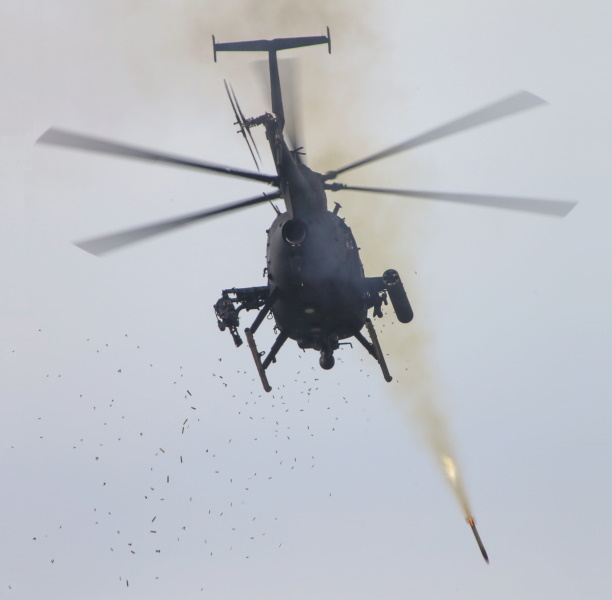
There were interim new-build models -- MH-6E / MH-6H / AH-6F / AH-6G / EH-6E -- based on the Model 500D or Model 500E, it's not clear which, and it seems even some based on the Model 520N, the NOTAR configuration being seen as useful for being quiet. The NOTAR machines, however, proved underpowered for the mission, and were quickly abandoned. In any case, the litter of variants finally converged on the "MH-6J" and "AH-6J", both based on the Model 530F, though it seems that initially the Model 520N was used, before NOTAR was abandoned.
The Little Birds have put in heavy service in the "dirty little wars" of America from the end of the Cold War, to the present day. All the fleet was upgraded to the "Mission-Enhanced Little Bird (MELB)" configuration from 2003 into 2007; the upgrades were performed by Boeing, which established an agreement with MDH for rights to enhancement of the Little Bird. The MELB featured an uprated engine, six-blade main rotor, four-blade tail rotor, Rockwell Collins glass cockpit, and other modernized avionics. The upgraded machines were redesignated "MH-6M / AH-6M". Both carry an imaging turret, but the AH-6M's turret includes a laser rangefinder / target designator. They have received further upgrades, such as more fuel and stronger landing skids, with new rotor blades and updated cockpit in the works. However, SOCOM is now looking for a replacement, with a decision to be made no earlier than 2024.
BACK_TO_TOP* MD Helicopters changed hands in 2005, following a financial crisis. The firm continued to sell, or at least support and upgrade, commercial machines, but dropped the "Defender" label. MDH also continued to sell machines to armed services, including an "armed MD 53OF", named the "Cayuse Warrior". It could carry a range of armaments, one munition on an attachment on each side, but it has a relatively unsophisticated combat avionics system, with night-fighting capability limited to NVGs and flares. A number of sales were made:
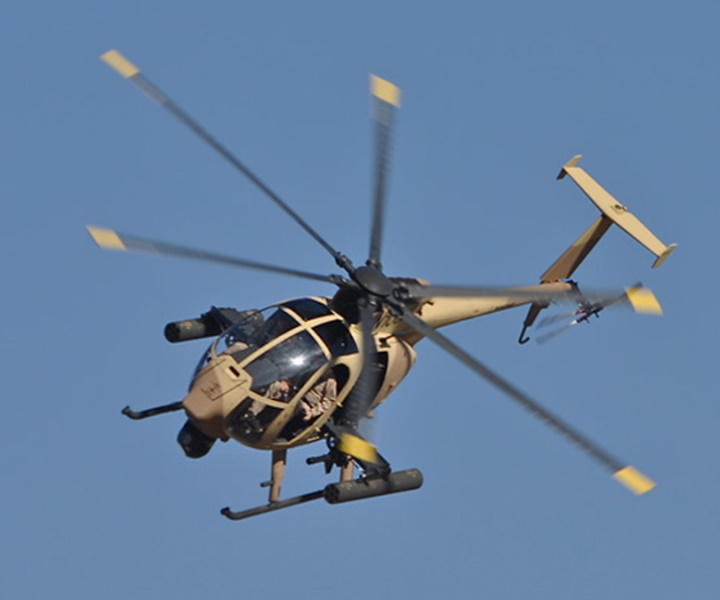
In 2015, MDH introduced an improved armed machine, the "MD 530G", with improved targeting systems, avionics, and armor protection, with a refined "Block 2" version then introduced. However, MDH went into bankruptcy in 2022, to emerge after re-organization, with the MD 530G disappearing from the product line -- with only the MD 530F and MD 530F+ surviving. However, it appears that the MD 530F+ may now actually the same as the MD 530G.
In 2024, MDH rebadged its machines, designating trainers as the "TH530", baseline attack machines as the "AH530", and the MD 530F+ as the "AH530 Block II". It is not clear if MDH has a future; the Ukraine War demonstrated that light helicopter gunships, lacking stand-off weapons, were highly vulnerable, and the future belonged to drones.
* In the meantime Boeing, working from the MELB, enhanced the MD 530F as the "AH-6i" -- the "I" meaning "International" and a focus on export sales. The AH-6i was announced in 2008, with initial flight in the fall of 2009.
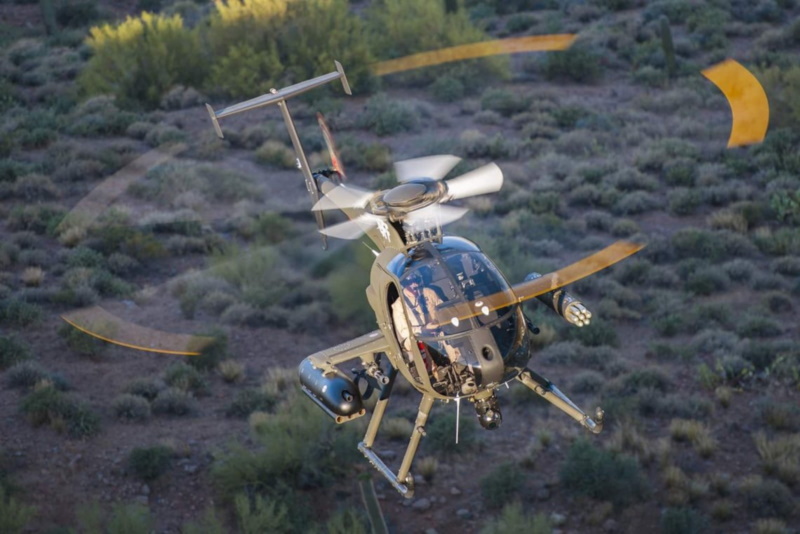
The AH-6i used an airframe obtained from MDH. It featured avionics and cockpit layout derived from the Boeing AH-64E Apache Guardian gunship. The AH-6i was powered by a Rolls-Royce Allison 250-C30R/3 turboshaft with full authority digital engine control (FADEC), providing 445 kW (600 SHP) -- the engine itself could generate more power, but it was limited by the dynamic system. The AH-6i had a six-blade main rotor, derived from that used on the MD 600N, and a two-blade tail rotor, as well as a full glass cockpit, a mission computer, and ruggedized landing gear to handle greater weights. It also had self-sealing fuel tanks and crash-worthy seats.
Unlike earlier armed H-6s, the AH-6i had four stores stations, not just two -- which at least in part explained the more powerful engine to handle the heftier stores loadout. In a representative armament configuration, one rack could carry an M-134 7.62-millimeter Gatling Minigun on the right inboard station and a 12.7-millimeter GAU-19 machine gun on the left inboard station. On the outboard stations, the helicopter carried two Hellfire missiles on the left side, and a seven-round M260 launcher for 70-millimeter unguided or laser-guided rockets on the right side.
Navigation, targeting, and guidance were provided by a day-night imaging, laser rangefinder / designator turret under the nose. The pilot performed targeting with a helmet-mounted display. The AH-6i was actually designed for the US Army's "Advanced Aerial Scout (AAS)" program, ironically to replace the Bell Kiowa armed scout in Army service; the Army version was to be designated the "AH-6S", with some enhancements relative to the AH-6i.
The AAS program collapsed due to funding cuts. With the collapse of the AAS program, Boeing switched its focus to foreign sales, with Saudi Arabia ordering a batch of 24 for the National Guard, receiving initial shipments in 2017.
Boeing also demonstrated an "AH-6U Unpiloted Little Bird", with initial autonomous flights from 2006. This led to a 2016 agreement with Korean Aerospace to develop an unpiloted attack variant of the Little Bird for the South Korean Army and the international market. A demonstrator was flown, but nobody bought it. However, in 2024 Thailand did order eight AH-6is to replace their aging AH-1F Cobra gunships, and Boeing continues to promote the machine. It is still not clear, in the light of the lessons of the Ukraine War, if the AH-6i has a future.
MDH unsurprisingly pressed legal complaints against Boeing for selling the AH-6i -- but in 2020, the courts decided in favor of Boeing, saying the company was within its rights as per the long-standing agreement with MD Helicopters, and told MDH to kindly be quiet.
BACK_TO_TOP* In the late 1980s, McDonnell Douglas began to investigating a new-design NOTAR utility helicopter, the "MDX", that would have about twice the empty weight of the MD 520N. It was announced in early 1988, with formal program start in early 1989, and initial flight of the first of three flight prototypes on 18 December 1992; there were also seven ground prototypes. First customer delivery of what was finally designated the "MD 900 Explorer" was in late 1994, not long before MD Helicopters was spun off from Boeing.
The MD Explorer was, as noted, bigger than the Series 500; it was also boxier in configuration, reminiscent of the MBB-Kawasaki BK 117, except for the NOTAR tail. The MD 900 was powered by twin Pratt & Whitney Canada (PWC) PW206B turboshafts with 470 kW (630 SHP) each. It used a high proportion of composite assemblies and a five-blade composite rotor, with the transmission system capable of handling 670 kW (900 HP) continuous power.
There was a single fuel tank under the floor, with a capacity of 602 liters (159 US gallons); an optional larger tank could handle 666 liters (176 US gallons). There were jettisonable forward-hinged doors on each side of the cockpit, and rear-sliding doors on each side of the passenger compartment. Dual controls were optional; there was seating for two in the cockpit, plus six in the passenger compartment. It was fitted with a partial glass cockpit. Other options included engine intake dust filters, a cargo sling hook, wire strike protection, an undernose imager, a rescue hoist, inflatable flotation gear, and various other accessories.

There was talk early on of an "MD 901 Explorer", with Turbomeca TM319-2 Arrius 2C turboshafts, apparently for export customers, but it didn't happen. In 1997, an updated configuration was introduced, with PW206E turboshafts, with various airframe tweaks, and updates to cockpit avionics. This variant was marketed as the "MD 902 Explorer"; it was updated in turn with PW207E engines, with 11% more take-off power, in 2000.
___________________________________________________________________
MD HELICOPTERS MH 902 EXPLORER:
___________________________________________________________________
main rotor diameter:
10.31 meters (33 feet 10 inches)
fuselage length:
9.86 meters (32 feet 4 inches)
footprint length:
11.84 meters (38 feet 10 inches)
height (rotor head):
3.66 meters (12 feet)
empty weight:
1,530 kilograms (3,375 pounds)
max loaded weight:
2,950 kilograms (6,500 pounds)
max loaded weight with external load:
3,130 kilograms (6,900 pounds)
cruise speed:
245 KPH (150 MPH / 130 KT)
service ceiling:
4,265 meters (14,000 feet)
hover ceiling (in ground effect):
3,245 meters (10,650 feet)
hover ceiling (out of ground effect):
2,675 meters (8,780 feet)
range:
590 kilometers (360 MI / 320 NMI)
___________________________________________________________________
The MD Explorer was not a hot product, only somewhat more than 150 having been sold, much lower than expectations. A "Combat Explorer" was demonstrated in the 1990s, being fitted with an undernose imaging turret and a top targeting turret, with unguided rocket or gun pods on stub attachments on each side; it could also be used for utility or medevac missions, but in any case, nobody bought it. The US Coast Guard evaluated the type as the "MH-90" from 1998 for interdiction of smuggling boats, as well as search and rescue, being armed with a 7.62-millimeter MAG machine gun on a flexible door mount. These machines were leased; the evaluation led to an open competition for operational mounts, with the Agusta A109E Power winning the award in 2000, and the MH-90s going back to MD Helicopters. It seems the Mexican Navy obtained a half-dozen MD 902 Explorers, but details are hard to find; some sources say they were armed, but photos do not bear that out.
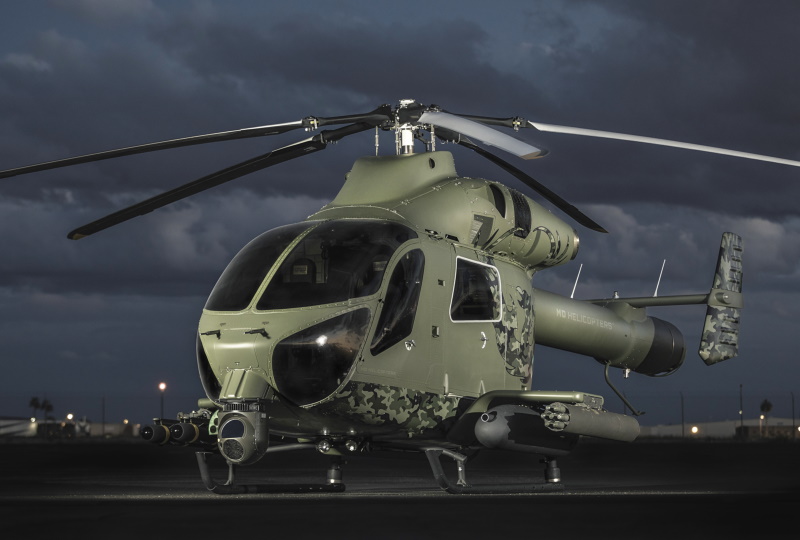
Despite, or possibly because of, the modest sales, MD Helicopters decided to revamp the Explorer, modernizing it and reducing cost, particularly by consolidating manufacture of redesigned assemblies under the MD Helicopters roof. A new model, combat-capable and designated the "MD 969 Combat Explorer", was formally launched in 2019. It was to feature a glass cockpit and a composite fuselage, with a capacity of six equipped troops. It could be fitted with a stores plank, with stations for four stores; it can also carry door guns and a seven-round "Common Launch Tube (CLT)" array in the cabin, with the CLT dispensing small smart bombs or other stores. Nobody bought it, and in fact production of the Explorer appears to have effectively ceased.
BACK_TO_TOP* As a footnote to the Series 500 story, from 1994, a company named Revolution Helicopter Corporation sold a scaled-down, single-seat copy of the Model 500D as the "Mini-500", as a kitbuilt flying machine. It was a convincing replica of a Model 500D, except for its much smaller size, a two-blade main rotor, and power plant consisting of a Rotax 582 two-cylinder, two-stroke piston engine providing 48 kW (64 HP).
Over a hundred Mini-500s were built and flown before Revolution went broke in 1999. The type had a bad reputation, with critics saying it was dangerous, a "piece of junk". However, kitbuilts in general have much the same bad reputation. Advocates say that bad reputation is overblown -- but even they have to admit that all flying machines are not to be piloted by the incompetent, and those that are built by the incompetent are by that factor just that more unsafe.
* Although NOTAR would seem to have significant advantages, surprisingly it had little effect on the helicopter industry, hardly making a dent in the prevalence of the main-tail rotor configuration. Flight reports don't suggest pilots have any problem with NOTAR; it may be a solution for a problem that few think is very troublesome, and simply doesn't look quite right to potential customers.
It is also interesting to note that the Series 500 and its offspring were all essentially the same machine as flown in the 1960s. One might think that reflected a lack of innovation; maybe so, but the reality is that helicopter design reached a sort of maturity in the 1960s. There have been tweaks such as improved engines, greatly enhanced avionics, plus improved rotor blades and other mechanical assemblies -- but nothing fundamental has changed.
* As far as sources go, there's unfortunately not all that much information on the H-6 available. I had to scrounge through a number of volumes of JANE'S ALL THE WORLD'S AIRCRAFT, and check out the manufacturer's website online. A YouTube video proved useful in doping out NOTAR, if not in revealing why NOTAR hasn't taken the world by storm.
* Illustrations credits:
* Revision history:
v1.0.0 / 01 feb 15 v1.0.1 / 01 jan 17 / Review & polish. v1.0.2 / 01 dec 18 / Review & polish. v1.1.0 / 01 nov 20 / Review & polish, illustrations update. v1.1.1 / 01 sep 22 / Review & polish. v1.2.0 / 01 jul 24 / Reorganization on MDH and AH-6i. (+)BACK_TO_TOP
